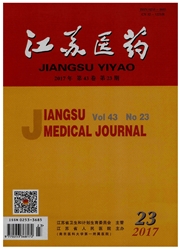

 中文摘要:
中文摘要:
目的探讨羰基-氰-对-三氟甲氧基本腙(FCCP)对脂肪酸结合蛋白3(FABP3)基因表达沉默的P19细胞线粒体功能的影响。方法构建FABP3表达沉默载体(A组)及相应的空载体(B组),包装病毒后感染P19细胞,建立稳定转染FABP3沉默的P19细胞株,采用实时定量PCR检测干扰效率。给予FCCP2.5〉mol/L(C组)、5〉mol/L(D组)干预FABP3沉默的P19细胞,采用荧光素酶化学发光法检测细胞ATP含量,流式细胞术观察线粒体膜电位的变化。结果B组FABP3基因表达量较A组下调(0.50±0.08vs.2.23±0.42)(P〈0.05)。与A、B组相比,C、D组细胞ATP生成减少(2.47±0.58、1.05±0.13vs.0.09±0.03、0.12±0.02)(P〈0.05),而细胞线粒体膜电位升高(358.36±12.23、389.66±12.13vs.437.35±9.27、473.21±19.65)(P〈0.05)。结论FABP3基因在维持P19细胞线粒体功能中发挥重要作用。
 英文摘要:
英文摘要:
Objective To investigate the effect of cyanide p-trifluoromethoxyphenyl-hydrazone (FCCP) on mitochondrial function of FABP3-silenced P19 cells. Methods The silencing vector of FABP3 in group A and the corresponding empty vector in group B were constructed and packaged with lentivirus and then transfected into P19 cells. After FABP3-silenced P19 cells were established, the efficiency to knockdown was detected by RQ-PCR. Beside.s, FABP3-silenced P19 cells were treated with FCCP 2.5 μmol/L in group C and 5μmol/L in group D, respectively. ATP production in P19 cells was determined by luciferase-based luminescence assay and mitochondrial membrane potential was measured by flow cytometry. Results The mRNA expression of FABP3 in group B was lower than that in group A(0.50±0. 08 vs. 2. 23±0. 42)(P〈0. 05). Compared with groups of A and B, the total ATP production in P19 cells was decreased(2.47±0. 58 and 1.05±0. 13 vs. 0. 09±0. 03 and 0. 12± 0. 02)(P〈0. 05), while mitochondrial membrane potential was increased(358. 36± 12.23 and 389. 66 ±12. 13 vs. 437. 35 ± 9. 27 and 473. 21 ± 19. 65) in groups of C and D(P〈0. 05). Conclusion FABP3 may play an important role in the maintenance of mitochondrial function in P19 cells.
 同期刊论文项目
同期刊论文项目
 同项目期刊论文
同项目期刊论文
 Knockdown of FABP3 Impairs Cardiac Development in Zebrafish through the Retinoic Acid Signaling Path
Knockdown of FABP3 Impairs Cardiac Development in Zebrafish through the Retinoic Acid Signaling Path Integrated Analysis of Dysregulated lncRNA Expression in Fetal Cardiac Tissues with Ventricular Sept
Integrated Analysis of Dysregulated lncRNA Expression in Fetal Cardiac Tissues with Ventricular Sept Silencing of FABP3 promotes apoptosis and induces mitochondrion impairment in embryonic carcinoma ce
Silencing of FABP3 promotes apoptosis and induces mitochondrion impairment in embryonic carcinoma ce Screening for differential methylation status in fetal myocardial tissue samples with ventricular se
Screening for differential methylation status in fetal myocardial tissue samples with ventricular se Overexpression of FABP3 promotes apoptosis through inducing mitochondrial impairment in embryonic ca
Overexpression of FABP3 promotes apoptosis through inducing mitochondrial impairment in embryonic ca 期刊信息
期刊信息
